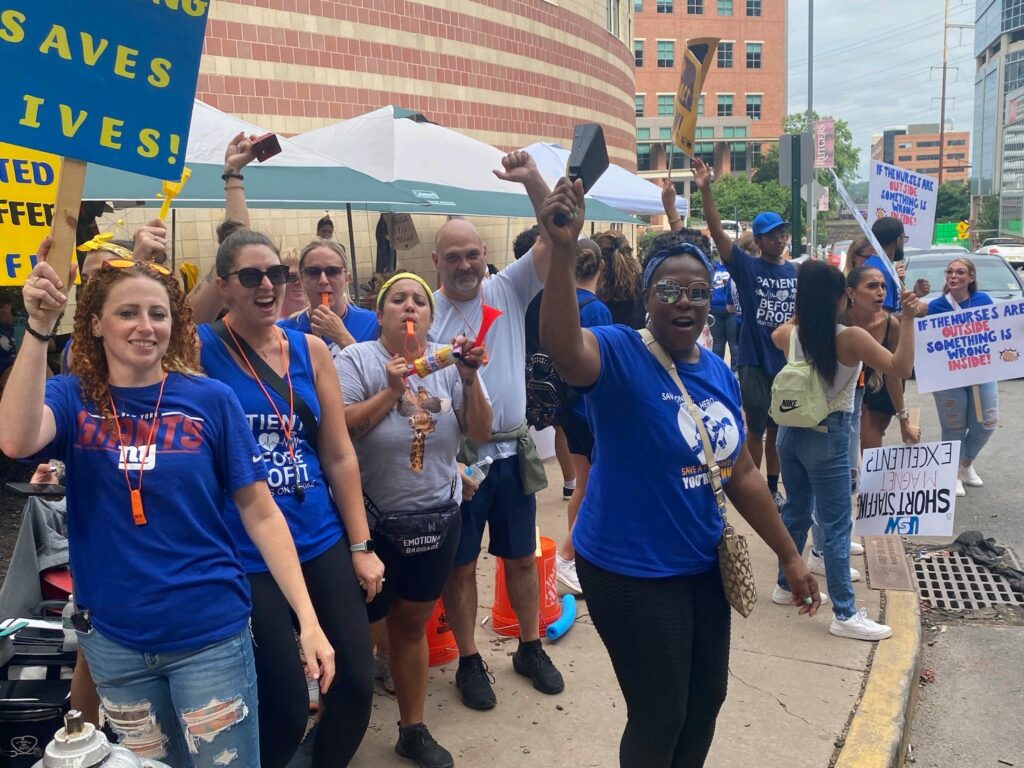Striking Nurses Feel Drive by Love from the Community

NEW BRUNSWICK-A few days into the nurses’ strike at New Brunswick’s Robert Wood Johnson University Hospital in New Brunswick and the outpouring of community support expressed for the nurses in the cacophony of car and truck horns echoes for blocks away.
Across the street from the Emergency Room entrance scores of nurses and their supporters cheer in appreciation for the outpouring of drive-by love. New Jersey AFL-CIO President Charles Wowkanech and AFL-CIO Secretary Treasurer Laurel Brennan have all come by.
Tuesday night the union is planning a community vigil in support of their members on the picket line. Both management and the union confirm that they are meeting the federal mediator tomorrow that’s been assigned to the labor dispute.
“We are here to support safe staffing—as much as the hospital wants to spin the narrative that they make that a priority they put profits first and we just want to just take care of our patients safely,” Jennifer Lowrey, a pediatric emergency room nurse, told InsiderNJ on the picket line. “The numbers speak for themselves—for every nurse that has to go over their [safe staffing] ratio, patient mortality increases by seven percent. Think how many lives are needlessly lost just because the hospital wants to put money over the lives of our patients.”
A RALLYING CRY
Back in May several hundred nurses and their supporters rallied in Trenton to support legislation introduced by Senator Linda Greenstein (D-14-Dist) to codify safe nursing staffing levels as was done over 20 years ago in California. At that rally, Debbie White, an RN and president of Health Professionals and Allied Employees, New Jersey’s largest healthcare union, cited peer reviewed research that tracked the overwhelmingly positive results of California’s adoption of such standards.
“They found this that for patients—a decreased likelihood of patient death-decreased admittance to critical care-improved patient outcomes-improved patient satisfaction-less hospital acquired infections, decreased patient readmissions and one of my personal favorites, less workplace violence,” White said back in May. “Healthcare workers are five times more likely to be assaulted than any other profession. If healthcare workers are safe, patients are safe.”
White continued. “Safe staffing not only makes patients and healthcare workers safer, it causes better retention of staff. Less turnover, which mean less orientation costs, because you know there’s a revolving door—they come in the leave-they come in-they leave—and better outcomes lead to better CMS [Centers for Medicare & Medicaid Services] reimbursement, less lawsuits—safe staffing saves money.”
The safe staffing bill has the support of the NJ AFL-CIO, JNESO District Council 1 IUOE-AFL-CIO, 1199J AFSCME, United Steel Workers Local 4-200, and Shore Nurses Union/NYSNA as well as patient advocacy groups like Citizen Action.
For its part, hospital management counters that “staffing levels at RWJUH are already among the highest in the state, and above those outlined within staffing legislation recently proposed in Trenton.”
“In fact, current staffing reflects 170 more nursing positions than required by the standards outlined in staffing legislation recently proposed in Trenton,” according to an RWJUH fact sheet. “RWJUH has added over 200 nurses to the budget to adjust for volume and acuity since May 2022, and added over 150 new nurses, net of attrition, since 2022.”
A NATIONAL CRISIS
Management concedes there’s a “nationwide nursing shortage” but says its vacancy rate that’s below ten percent is better than the 16 percent national average.
New Brunswick is one of a dozen acute care hospitals in the RWJBarnabus system that has a partnership with Rutgers University which makes it the state’s largest academic healthcare system. It has 38,000 employees and $6.6 billion in revenue. The New Brunswick facility has both the distinction and challenge of being just one of only three Trauma Level One hospitals in the state which means it serves the sickest patients in several counties of the state.
Like every hospital in the state, it experienced the collective trauma of the mass death event that took the lives of over 1.1 million Americans and is still killing them all, though in much lower numbers.
For much of the worst of the pandemic, New Jersey was the global epicenter with the highest per-capita death rate in the world. As NJ.com reported in December of 2020, our death toll of 200 per 100,000 “was higher than any state in the nation and far above the national rate of 85 deaths per 100,000.”
“It’s even higher than the cumulative death toll in Belgium, the hardest-hit nation, which has 150.9 deaths per 100,000 residents, according to World Health Organization data. Put another way: If it were a country, the Garden State would have the highest COVID-19 per capita death toll in the world.”
Clearly, New Jersey’s hospitals, like the rest of the nation, were wholly unprepared for the long-predicted pandemic that found the nation flying without a reliable public health safety net. Short staff and even the basics like N-95 masks, thanks to decades of cost cutting and profit taking, brought the world’s wealthiest nation to its knees.
Not being prepared had some real consequences, particularly for healthcare professionals who bore the brunt of the collapse of infection control. The Guardian newspapers and Kaiser Health News reported that 3,600 hospital workers died in the first year of the pandemic due to their occupational exposure. 700 of them were from New York and New Jersey. Two-thirds of them were people of color.
“I think when COVID hit everybody was very much surprised and at that point many nurses left the profession—they were afraid of the COVID disease,” recalled Judy Danella, president of the United SteelWorkers Nurses Local 4-200 on WBAI. “It was an unknown disease and many of them said ‘I don’t want to expose myself or my family to this disease.’”
Danella said that on the picket line she was told by a colleague that in one day of the pandemic she had to wrap seven bodies.
The union president is concerned that hospital management didn’t learn anything from the pandemic.
“I don’t know where we go if there is another pandemic coming,” Danella said. “Now, I had a COVID patient two months ago and they didn’t even isolate that patient.”
So far, the public messaging from the union and management couldn’t be more divergent with the hospital insisting that RWJUH nurses are already the highest paid in the state, something the union disputes.
Carol Tanzi is an RN in the Pediatric Recovery Room who says that as one of only three of the state’s Trauma Level One hospitals, the pediatric patients she sees at RWJUH are the ones that demand the most focused nursing attention.
“For years it’s become quite apparent that there is a big disconnect between administration and staffing, specifically for nurses and nursing assistants so that what we need has not been recognized—what we need is what the patients need and the patients we see are the ones with the highest acuity and the hospital has not recognized that means more staffing,” Tanzi told InsiderNJ on the picket line.
HEALING OR WEALTH BUILDING?
The union notes that the hospital system’s recently retired CEO and Present Barry Ostrowsky earned $16 million in the second year of the pandemic, making him the highest paid hospital executive in the New York area, according to Crain’s New York. Ostrowsky now sits on the board of directors of PSE&G.
Tanzi observes that even though as licensed professionals she and her colleagues “are the biggest advocates for their patients” the hospital’s management squanders millions “because there’s no shortage of money to go to executives and consultants to talk about the problems that we have that as nurses we could quickly outline. Unfortunately, healthcare has become a money driven business and that’s the one place it shouldn’t be.”
Tanzi was joined on the picket line by her daughter Emily, who works in New York City as a medical researcher investigating Alzheimer’s disease. She was gathering signatures from construction workers on RWJUH’s adjacent Jack and Sheryl Morris Cancer Center, a 12-story $750 million project due to be completed at the end of 2024.
“I am here to support my mother who supported me with all of my endeavors—educational—political—you name it,” Emily told InsiderNJ. “I am here to lend whatever knowledge and energy I have to support the nurses for safe staffing.”
As for her petition, it was an open letter from Emily’s grandmother, a “public servant for the Edison Board of Education” to Gov. Murphy “urging him to support the nurses.”
InsiderNJ queried the Governor’s office about Emily’s petition looking for an expression of support from Murphy for her mother and the other 1,650 nurses on strike.
“The Governor recognizes and values the hard work of nurses at Robert Wood Johnson University Hospital, who provide critical services to countless patients,” wrote Christi Peace, a deputy press secretary for Gov. Murphy. “The Governor remains a strong proponent of organized labor and believes employees deserve a seat at the table when negotiating labor matters. The Administration encourages both parties to maintain an open dialogue and will continue to remain engaged with them as they work towards a fair and acceptable resolution to these negotiations.”








Leave a Reply